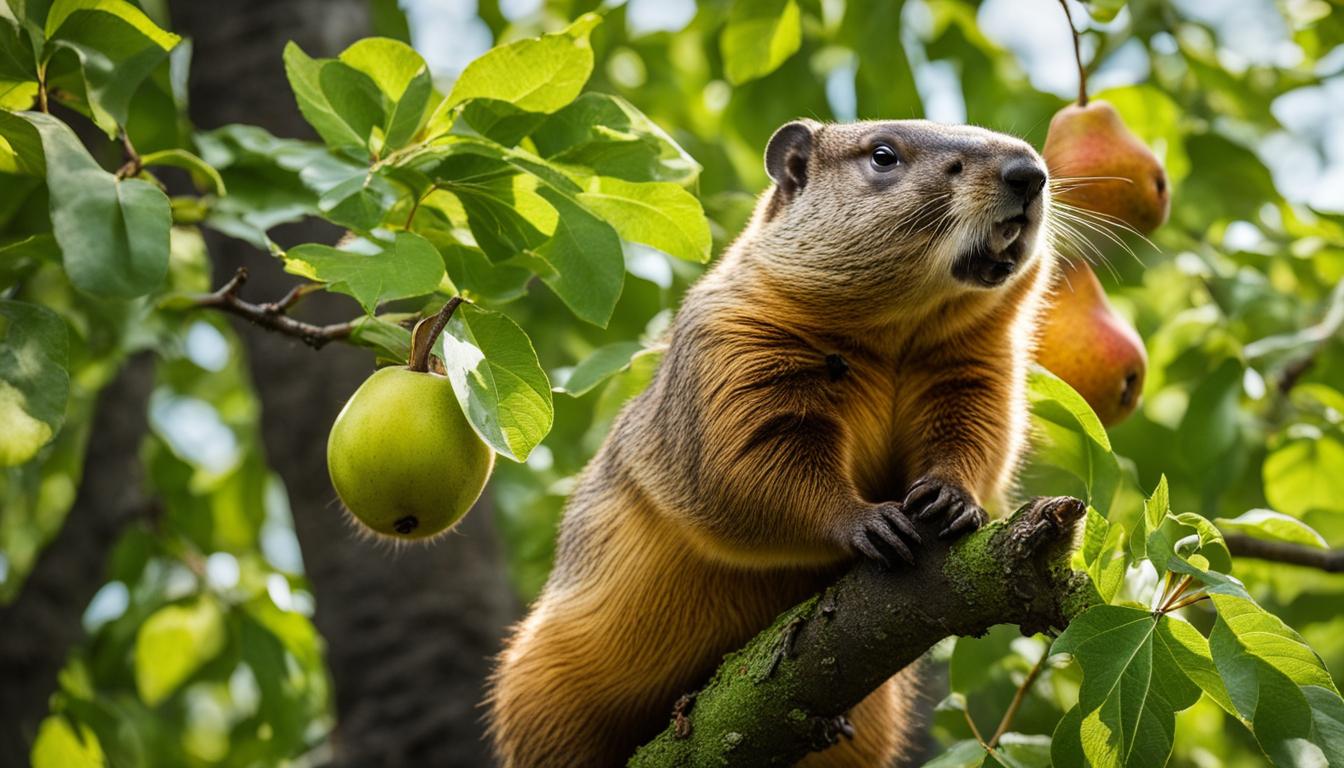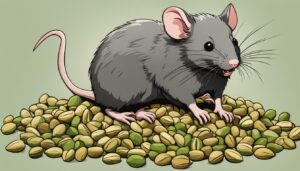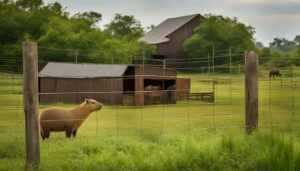When it comes to the diet of groundhogs, there is often curiosity about their food preferences and habits. One question that frequently arises is whether groundhogs eat pears. To shed light on this topic, let’s delve into the world of groundhog feeding habits and explore the truth behind their consumption of pears.
Key Takeaways:
- Groundhogs are primarily herbivores, consuming plants, vegetables, and fruits.
- Pears are part of a groundhog’s diet, along with other fruits like apples.
- While groundhogs primarily eat plants, they may occasionally consume small live organisms.
- Groundhogs have a digestive system well-suited for processing plant matter, including pears.
- Pears provide nutritional value to groundhogs, contributing to their overall diet.
Groundhog Diet and Preferences
Groundhogs are herbivores and have a varied diet that consists of plant-based foods. Their preferences include herbs, clover, alfalfa, and dandelions. These items make up the majority of their diet, providing them with essential nutrients and energy. However, groundhogs also have a fondness for certain garden fruits and vegetables.
Among their favorite foods are berries, apples, lettuce, corn, and carrots. These fruits and vegetables add variety to their diet and offer additional nutrition. While groundhogs primarily rely on plants, they occasionally exhibit omnivorous behavior by consuming small live organisms such as snails, grasshoppers, and larvae. However, it is important to note that live food sources only make up a small percentage of their overall diet.
Groundhog Diet and Preferences
A table can be used to illustrate the various foods that groundhogs prefer and consume.
| Favorite Foods | Preferred Fruits and Vegetables |
|---|---|
| Herbs | Berries |
| Clover | Apples |
| Alfalfa | Lettuce |
| Dandelions | Corn |
| Carrots |
As shown in the table, groundhogs have a diverse palate when it comes to fruits and vegetables. They enjoy a variety of options that provide them with different flavors and nutrients. While their main focus is on plant-based foods, groundhogs also incorporate these preferred fruits and vegetables into their diet when available.
What Other Fruits Do Groundhogs Eat?

In addition to pears, groundhogs have a taste for a variety of fruits. They enjoy indulging in apples, berries, cherries, and even watermelon. While their main focus is on their plant-based diet, groundhogs will readily consume fruits when available. Their preference for a diverse range of fruits showcases their versatility as foragers and their ability to adapt to different food sources.
Groundhog Fruit Consumption
When it comes to fruit consumption, groundhogs display an affinity for the juicy goodness of apples. These sweet treats, along with pears, are among the favorite fruits of groundhogs. Whether they stumble across an apple tree or a patch of berries, groundhogs are not shy about satisfying their fruity cravings.
Groundhogs’ fondness for fruits is not surprising given the nutritional benefits they provide. Fruits like apples and pears offer a rich source of vitamins, minerals, and antioxidants that contribute to the overall health and well-being of these furry creatures. While their diet mainly consists of plants, the inclusion of fruits adds variety and essential nutrients to their daily intake.
| Fruit | Nutritional Benefits for Groundhogs |
|---|---|
| Apples | High in fiber, vitamin C, and antioxidants |
| Pears | Rich in fiber, vitamin C, and potassium |
| Berries | Source of antioxidants and beneficial plant compounds |
| Cherries | Provide antioxidants and anti-inflammatory properties |
| Watermelon | Hydrating and offers vitamins A and C |
By incorporating these fruits into their diet, groundhogs not only enjoy a flavorful feast but also enhance their nutritional intake. The burst of sweetness from apples, pears, and other fruits adds a delightful touch to their foraging adventures.
Do Groundhogs Eat Nuts?

While groundhogs are primarily herbivores, nuts are not a significant part of their diet. Groundhogs do not actively seek out nuts as a food source, and their main focus is on consuming plants, vegetables, and fruits. However, on rare occasions, groundhogs may come across nuts and consume them.
It’s important to note that groundhogs’ digestive systems are not specifically adapted to process nuts. Their teeth are better suited for chewing plant matter, and their digestive system is designed to break down and extract nutrients from plant-based foods. As a result, groundhogs may not digest nuts as effectively as they do other food sources.
Overall, while groundhogs may occasionally eat nuts, it is not a significant part of their diet. They primarily rely on consuming a variety of plants, vegetables, and fruits to meet their nutritional needs.
Are Groundhogs Omnivores?

Groundhogs, also known as woodchucks, are primarily herbivores, but they do exhibit some omnivorous behavior. While the majority of their diet consists of plants, vegetables, and fruits, they may occasionally consume small live organisms such as insects. However, it’s important to note that these live food sources make up a small percentage of their overall diet. This behavior classifies groundhogs as herbivores with some omnivorous tendencies.
Groundhogs have a preference for plant-based foods and are commonly observed grazing on herbs, clover, alfalfa, and dandelions. They also enjoy indulging in the fruits of gardens, such as berries, apples, lettuce, corn, and carrots. While groundhogs primarily rely on these plant-based foods, it’s interesting to see their occasional interest in small live organisms. This flexible diet allows groundhogs to adapt to their environment and make use of available food sources.
It’s important to highlight that while groundhogs may exhibit omnivorous behavior, their overall classification remains as herbivores. Their digestive system is well-suited for processing plant matter, and the addition of small live organisms to their diet is more of a supplement rather than a staple. So, while groundhogs may occasionally consume insects or other small animals, their primary focus remains on consuming a variety of plants, vegetables, and fruits.
It’s fascinating to study the diet classification of animals and understand the nuances of their food preferences. Groundhogs, with their primarily herbivorous diet supplemented by occasional omnivorous behavior, provide a unique example of adaptability in the animal kingdom.
Table: Groundhog Diet Classification
| Diet Type | Main Food Sources | Supplemental Food Sources |
|---|---|---|
| Herbivore | Plants, vegetables, fruits (e.g., herbs, clover, alfalfa, dandelions) | – |
| Omnivore | – | Insects, small live organisms |
As seen in the table above, groundhogs primarily fall under the classification of herbivores, with their main food sources consisting of various plants, vegetables, and fruits. While they occasionally exhibit omnivorous behavior by consuming small live organisms, this behavior is not their main focus. Groundhogs exemplify the fascinating diversity in animal diets and how they adapt to their surroundings to meet their nutritional needs.
Can Groundhogs Digest Pears?

Groundhogs have a digestive system that is well-suited for processing plant matter. While it is not specifically known if they can digest pears with ease, their ability to consume a variety of fruits suggests that they can effectively process the nutrients present in pears.
Groundhogs, being primarily herbivores, have specialized digestive systems that allow them to break down and extract nutrients from plant materials efficiently. Their digestive tract includes adaptations such as a large cecum, which aids in the fermentation of plant fiber and the extraction of nutrients. These adaptations suggest that groundhogs have the capacity to digest and derive nutritional value from pears.
While further research may be needed to fully understand the digestive capabilities of groundhogs when it comes to pears, their ability to consume a diverse range of fruits indicates that their digestive systems are capable of processing the nutrients found in pears effectively.
In conclusion, while the specific details of pear digestion by groundhogs may require further investigation, their overall diet and digestive adaptations suggest that they can digest pears without difficulty. The ability of groundhogs to consume pears, along with other fruits, adds variety to their diet and contributes to their overall nutritional intake.
Nutritional Value of Pears for Groundhogs

Pears are not only a delicious fruit for humans but also offer nutritional benefits for groundhogs. These furry creatures can benefit from incorporating pears into their diet due to the various vitamins and minerals they contain. Pears are a good source of fiber, which aids in digestion and helps prevent gastrointestinal issues in groundhogs. Additionally, pears are rich in vitamin C, an essential antioxidant that supports the immune system and overall health.
In terms of minerals, pears provide groundhogs with potassium, an electrolyte that helps maintain proper heart function and regulates fluid balance in the body. This mineral is particularly important for groundhogs, as they rely on a well-functioning cardiovascular system for their burrowing activities and overall survival. Furthermore, the natural sugars present in pears can provide groundhogs with a quick energy boost, helping them sustain their daily activities.
Nutritional Value of Pears:
| Nutrient | Amount per 100g |
|---|---|
| Calories | 57 |
| Protein | 0.4g |
| Fat | 0.1g |
| Carbohydrates | 15g |
| Fiber | 3.1g |
| Potassium | 116mg |
| Vitamin C | 4.3mg |
While groundhogs primarily rely on plant-based foods, the inclusion of fruits like pears can provide them with additional nutrients to support their overall well-being. It is important to note that pears should be given to groundhogs in moderation, as with any new food introduced to their diet. These creatures have specific dietary needs, and a balanced approach is crucial to ensure their health and longevity.
Groundhogs and Apples: A Common Association

Groundhogs are often associated with eating apples due to their preference for a variety of fruits. Along with pears, apples are a popular choice among groundhogs when it comes to their dietary preferences. While groundhogs primarily consume plants and vegetables, they readily consume apples if they are available.
Apples provide a sweet and crunchy treat for groundhogs, offering them a source of hydration and essential nutrients. In their natural habitat, groundhogs have been observed taking bites out of apples, enjoying the juicy and flavorful flesh. Although apples are not the main component of a groundhog’s diet, their consumption contributes to the overall variety of food that groundhogs are known to enjoy.
Like pears, apples offer nutritional benefits to groundhogs. They are a good source of vitamins and minerals, including vitamin C and potassium. Not only do groundhogs find apples tasty, but they also provide them with essential nutrients that support their health and well-being.
Table: Nutritional Comparison of Apples and Pears for Groundhogs
| Nutrient | Apples | Pears |
|---|---|---|
| Fiber | 2.4g | 3.1g |
| Vitamin C | 4.6mg | 4mg |
| Potassium | 107mg | 116mg |
The table above provides a nutritional comparison of apples and pears for groundhogs. While both fruits offer similar amounts of fiber and vitamin C, pears have a slightly higher potassium content. However, both apples and pears contribute valuable nutrients to a groundhog’s diet.
Conclusion
In conclusion, groundhogs are primarily herbivores with a diverse diet that includes plants, vegetables, and fruits. While pears are not their main food source, groundhogs have been observed consuming pears, along with other fruits like apples, berries, and cherries. The addition of fruits like pears provides nutritional value to groundhogs and contributes to their overall diet.
Groundhogs’ ability to digest a variety of fruits suggests that they can effectively process the nutrients present in pears. Although their digestive system is well-suited for processing plant matter, it is not specifically known if they can digest pears with ease. However, the fact that groundhogs readily consume pears indicates that their digestive system can handle this fruit.
Overall, pears offer essential vitamins, minerals, and fiber to groundhogs. These nutritious fruits, along with other plant-based foods, contribute to the well-being and nutritional intake of groundhogs. While groundhogs are primarily known for their herbivorous behavior, their occasional consumption of fruits like pears adds variety and nutritional benefits to their diet.
FAQ
Do groundhogs eat pears?
Yes, groundhogs have been observed eating pears as part of their diet.
What do groundhogs primarily eat?
Groundhogs are herbivores and primarily consume plants, vegetables, and greens.
What other fruits do groundhogs eat?
In addition to pears, groundhogs enjoy eating fruits such as apples, berries, cherries, and watermelon.
Do groundhogs eat nuts?
Groundhogs do not actively seek out nuts as part of their diet, but they may occasionally consume them if they come across them.
Are groundhogs omnivores?
Groundhogs are primarily herbivores but may exhibit some omnivorous behavior by consuming small live organisms like insects.
Can groundhogs digest pears easily?
While it is not specifically known if groundhogs can digest pears with ease, their ability to consume a variety of fruits suggests they can effectively process the nutrients present in pears.
What is the nutritional value of pears for groundhogs?
Pears are a nutritious fruit that can provide essential vitamins and minerals for groundhogs, including fiber, vitamin C, and potassium.
Do groundhogs eat apples?
Yes, groundhogs have been observed eating apples along with other fruits like pears.
What is the conclusion regarding groundhog diet and fruit consumption?
Groundhogs primarily consume plants, vegetables, and fruits, including pears and apples, as part of their diet.




